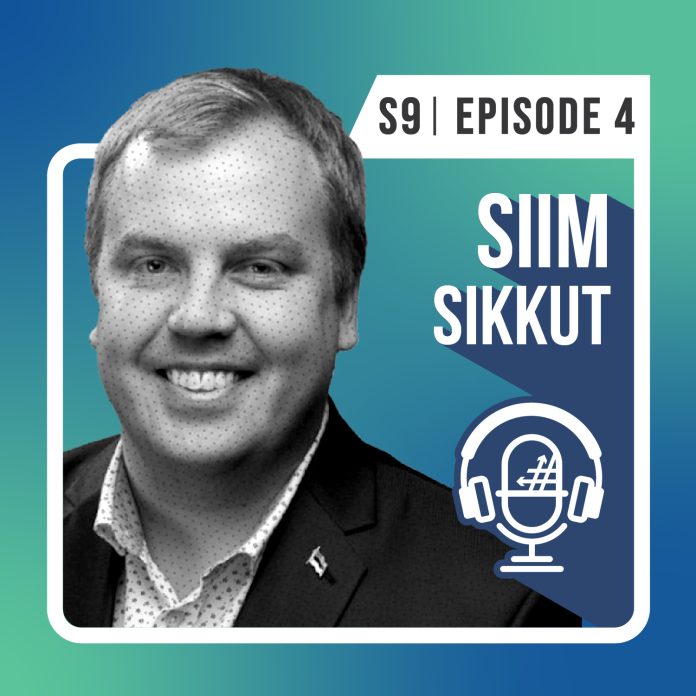Do you ever imagine living in a more digitized society, one where you don’t have to go to your local school or library to vote or under long lines of the DMV?
Today, I’m talking to Siim Sikkut, the former Government CIO of Estonia, for a look at some small, yet highly effective changes that make civic life easier and more effective. For more than 20 years, this country has leveraged technology to make the most of limited resources while quietly becoming one of the most digitally advanced nations in the world.
What can we learn from Estonia’s success? Pack your bags for an audio voyage and let’s find out.
In this episode:
Estonia as a Digital Hub
As we started building up the whole digital country about 20 years ago, the premise has always been to accept that there are risks of being digital. We can be attacked, and we have to manage those risks. So, that’s what we really started building up from early days on—how to be cyber secure in terms of how we design our systems, how we build up defenses, and how we build alliances internationally for that.
Estonia started going digital to be as efficient and effective as we can. We are such a small nation. We are 1.3 million people, but still in our big, bad neighborhood, we have to have our defense up and people expect the same level of welfare as in our neighboring Nordic countries.
We realized that if we want to be a fully-fledged country, we have to use all the resources we have in the best and most efficient way. That led us to many reforms in economic policy and in society that also led to experiments with digital technologies at the time when the internet was just starting to go mainstream in the late nineties.
Two of our biggest drivers were also the backdrop of other crises back in the day—the Asian financial crisis in 1997 and the 1998 Russian economic crisis. These two meant that when the government was coming in ’99, there was a dire need to cut back public expenditure and bring in mass savings programs.
So basically, a few experiments had been happening in the digital front, and then there was a government need—and all these things converged. From these early experiments, it really showed that we can indeed reap the benefits and have shown us directions beyond our way. It became a conscious strategy for the government and leadership from there on.
Through the years, the drivers have become more multifold. These days, it’s also about meeting people’s expectations. Once our citizens had a taste of being digital, they wanted more. And then now that the world has become more digitized, then obviously, the government too has to be in that game. There’s no other option anymore.
The First Experiments: The Value of Political Will
Some of the first experiments were taking out taxation to pay, making it easy to pay taxes online; bringing in digital signatures, so anything can be signed digitally; and then bringing in digital identity to access services online. These first steps proved to be valuable.
But all these were also possible because of political will. That’s important too. There has to be a will to try stuff. Once you see it in action, then it’s a pragmatic choice to do more or want more, in a way.
That’s been the beginning of the story for us. I am often asked, “Is there a political debate about being digital in Estonia?” No, not for years now anymore because everybody has seen and felt it in practice and saw its value.
A Day in a Life: 99% Online Public Services
On average, Estonians come across some sort of government interaction a few times a year. Since our government services are digitized, almost any government interaction can be done online. The only exceptions are—and it sounds like a joke, but it’s actually true—to get married and to get divorced, which of course, you still have to show up for.
Technically, we could even do that from a distance, but first, we have world traditions. Secondly, legally speaking, if I take all romance away from getting married, we want to make sure you’re not being coerced into marriage, for example, even with a prenup. So, you have to see somebody at least.
But any other application—for some benefit or reporting to the government for compliance as an entrepreneur—or anything at all where you need to come across with the bureaucracy, that can be done digitally and by yourself.
Paying Taxes in Estonia: A Three-Minute Transaction
Paying taxes is especially a fun thing for my having lived in the states, especially. We didn’t even know what checks are because we were able to go straight to online banking in our case.
We’ve managed to make it easy to get taxes done. Filing your taxes is a three-minute thing once a year for us. In our case, your employer pays the taxes as they pay your salary. So, your data—what you’ve earned, what was collected—it’s all on a running basis. At the end of the year, if you have to do your taxes, that data is just presented back to you.
Unless you have a special case, like having foreign income, then 95% of our people don’t change anything in their tax declaration. They just basically go online, review it, next, next, next, submit, and done.
Securing Users’ Personal Information Data
And then the data you submitted—there’s ways of securing that. In Estonia, we operate based on a few principles. One of them is ‘once only’, which means that if some part of the government already knows something about you already, the rest should not ask again. That’s a legal principle to follow.
Another principle is that data can be reused often by default, if a law permits it. Of course, we have to make sure that you specifically consented for your data to be used. But you can opt out. If you don’t like your data to be used, you can still choose to submit all your data to the tax agency again.
But almost nobody does that because of the convenience of opting in. If you’re really concerned, you could always have the option of not having an easy tax declaration. But it’s really important to at least give people the chance to opt in.
The Case of Healthcare: Digital Health History
Since 2007, we have a Digital Health History built up. Each time I go to see a doctor, there’s a trace of that that ends up being part of my national file, so to speak. That is available for me, obviously, and for the next doctor I go to see.
Not only does it save time, but it also allows for better treatment. That data can be used to build preventive medicine, and all those other benefits unlocked with that.
But, again, privacy has to be protected. First of all, we are part of Europe, and so the infamous GDPR applies to us. Also, we have taken care to really build the features of personal data management. Healthcare is possibly my most sensitive data, so I have a granular view of who accesses that from a logged file—which doctor looked at my files, if police looked into my records somewhere, if it’s used in an investigation by the data protection office.
And so, I have control in terms of what happens to my data. I can even block the next doctor from seeing my past records if I want to. These are very simple technical solutions that are also very powerful to help gain our people’s trust.
Moving to Estonia
Once you move to Estonia, you then become a student resident. And with that, you get a digital identity—that’s an ID card with a smart chip, like a bank card or a mobile ID. With that, you will have a key to access all the services online. By this point, almost all the services are available in English language as well.
But the good news is that you don’t even have to move. You can virtually become an Estonian even by being in DC or wherever in the world with this program called E-residency. You can become a virtual resident of Estonia, you get the same key, and you can, for example, set up a company and run that European company from the comfort of your home or your office or wherever in the world.
E-residency: Security and Benefits
We are very blunt about one thing: there’s no way you can a hundred percent prevent bad things from happening. There’s never going to be a hundred percent secure system. You just have to build up your defenses and your mechanisms as strong as you can.
To keep E-residents secure, we check every little background of the people that apply. If for any suspicion you may not be as clean as we think you are, we immediately stop and close the investigation.
Being an e-resident does not make you a citizen. You don’t even get a visa. But this is really the key to our digital space. You get an identity, and you get access to the services we provide. It’s a digital passport to enter our digital service space that the government has built up.
One key benefit for this is for setting up a European company. You can be a trusted partner in European single market, and you don’t have to pay some middlemen to hold your company in another country with a bigger bureaucracy.
But another is for the digital nomads. They usually need some jurisdiction base to operate from—to send the invoices from—and that’s where e-residency is so handy. Our digital nomad visa was one of our first attempt to say to the digital nomads of the world to consider Estonia as one of the stops on their way, with the hope that if they come here, then our ecosystem may attract them to stay longer.
It’s a way to try to attract entrepreneurs and new business to the country. With COVID, we saw that interest is high, but people are just not moving enough yet, so we’re still looking forward to that.
Adjusting to the Pandemic: Solving Specific Needs
First of all, as a digital country, we were indeed ready at some point. Because all the services have been available digitally, switching to remote work or remote study was not that much of a big deal.
But a few things still emerged. Every crisis brings its own specific needs. For example, with COVID, we needed to manage personal protective care on a national level. Building a management system up was an immediate need to get the data flowing from COVID labs to national statistics and with regards to COVID contact tracing.
We tried to solve these specific needs by doing what we’ve always done: relying on good partnerships with the private sector and being very open to this innovation.
Quite frankly, this experience also exposed where we haven’t been as strong and showed us what we need to strengthen. But that’s good because that makes you resilient for the next challenge that may happen.
So now having been through COVID, this crisis has added to Estonia’s digital journey an even better understanding of how to really be resilient on society level. Whatever comes next, you must know how to quickly react to that and know what building blocks you need in place in your digital infrastructure to be ready for whatever comes your way.
Make #ShiftHappen in the New Normal
If I had to trim down the three things (and this is going to sound a bit cliche but hear me out):
- Today’s buzz word is really all about digital transformations. But what that fundamentally means is that we are not solving a technological problem. Technology is the same everywhere, so what matters is the way we use it.
- In order for it to work, we have to properly do change management. And that’s a mindset thing. That’s how leaders must approach it. That will be rooted in classic routine practices. You have to communicate. You have to get stakeholders on board. Don’t treat it as a technology uptake project. You have to manage this transformation as a change.
- Collaborate and be open. In Estonia, we’ve been keenly aware that we will not ever have the best minds of the world. And we will never have the best minds of the country, even in government. And so, we had to work with the private sector. We use the best global solutions. We don’t have any shame in copying others. If something works elsewhere, we’re taking it up from there. It doesn’t have to be rocket science. You just have to be really open and partner up, and that’s where magic can happen.
Today’s takeaway from Siim:
“Government solutions should not necessarily be high tech, state of the art, and bleeding edge. A lot of this comes down to the process design. Efficiency comes from how we design the process and the service behind to be use-centric.
Design matters way more than the tech in this game.”
Episode resources
E-residency: What is e-Residency | How to Start an EU Company Online (e-resident.gov.ee)
More about e-Estonia: Home page – e-Estonia
Subscribe where you get your podcasts! Search for “#ShiftHappens” in your favorite podcast app.






